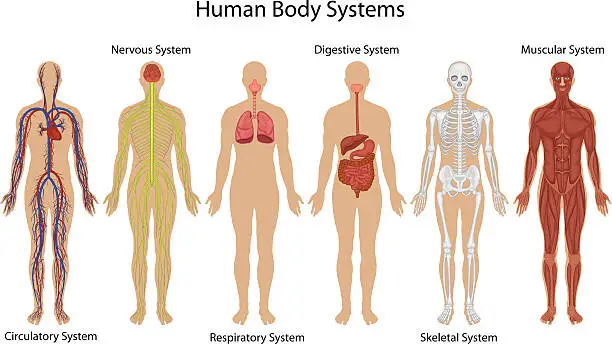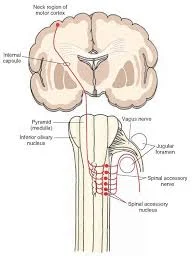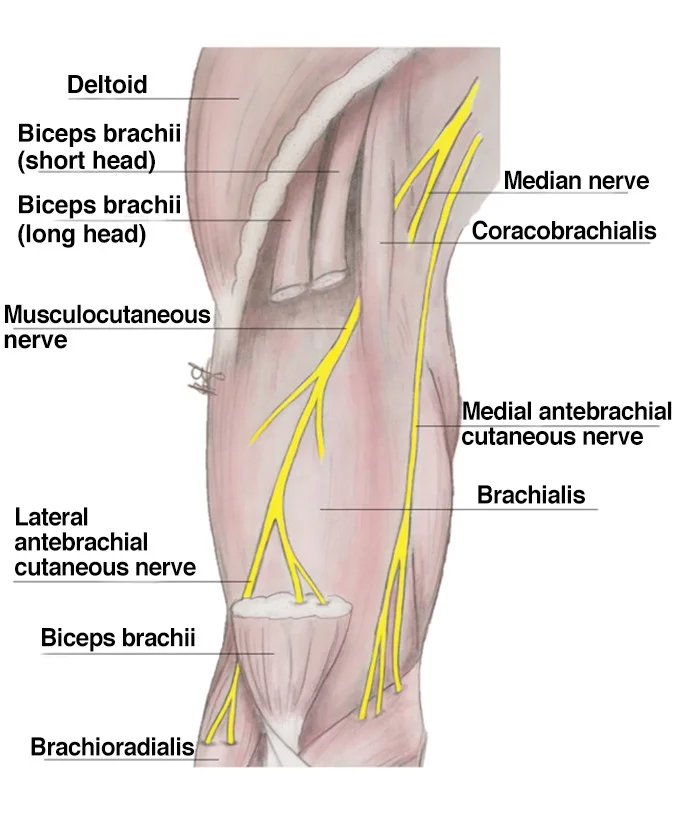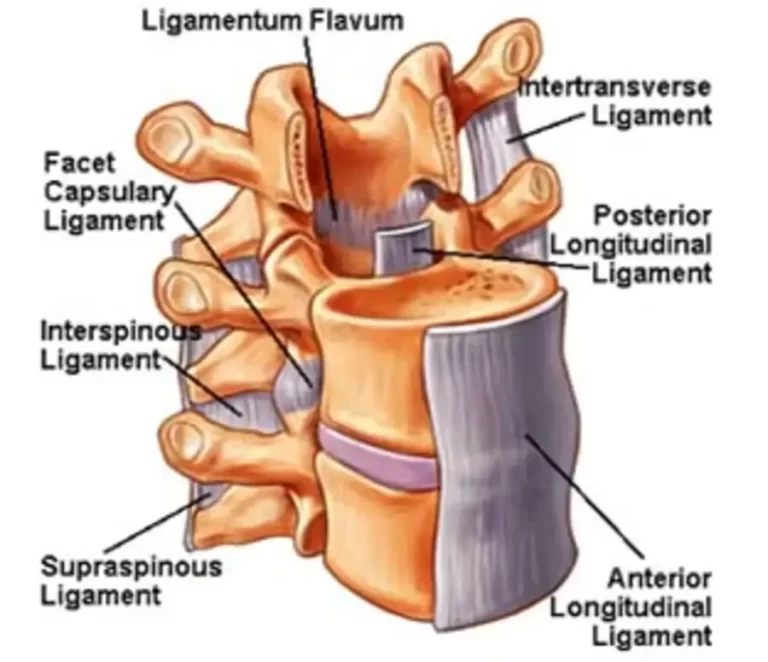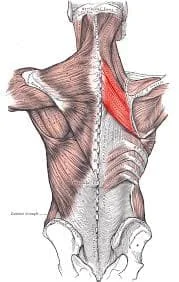Human Body Parts
Introduction
First of all, the human body parts are incredibly amazing. Every one of the numerous parts that comprise the human body serves a particular function. We carry out all tasks with our bodies. Let us educate you with the many names for our body parts.
Body parts are the different sections of an individual that allow us to move and sense our environment, such as our mouth, nose, arms, and legs. Check out the list of names below for the different bodily parts.
The human body can be thought of as a complex machine with many moving parts. The many body parts keep it preserved by functioning normally. Our brain serves as the control center, assisting us in thinking and emotion. Our energy comes from the blood that our heart pumps.
Oxygen is taken up by our lungs during breathing. Our bones give our body the shape of a frame. Our skin shields us from harm and feels touch. Our muscles enable us to move. Our bodies cooperate to sustain our life. A quick summary of some of the bodily parts and their functions may be found in the article below.
The Head
The Brain
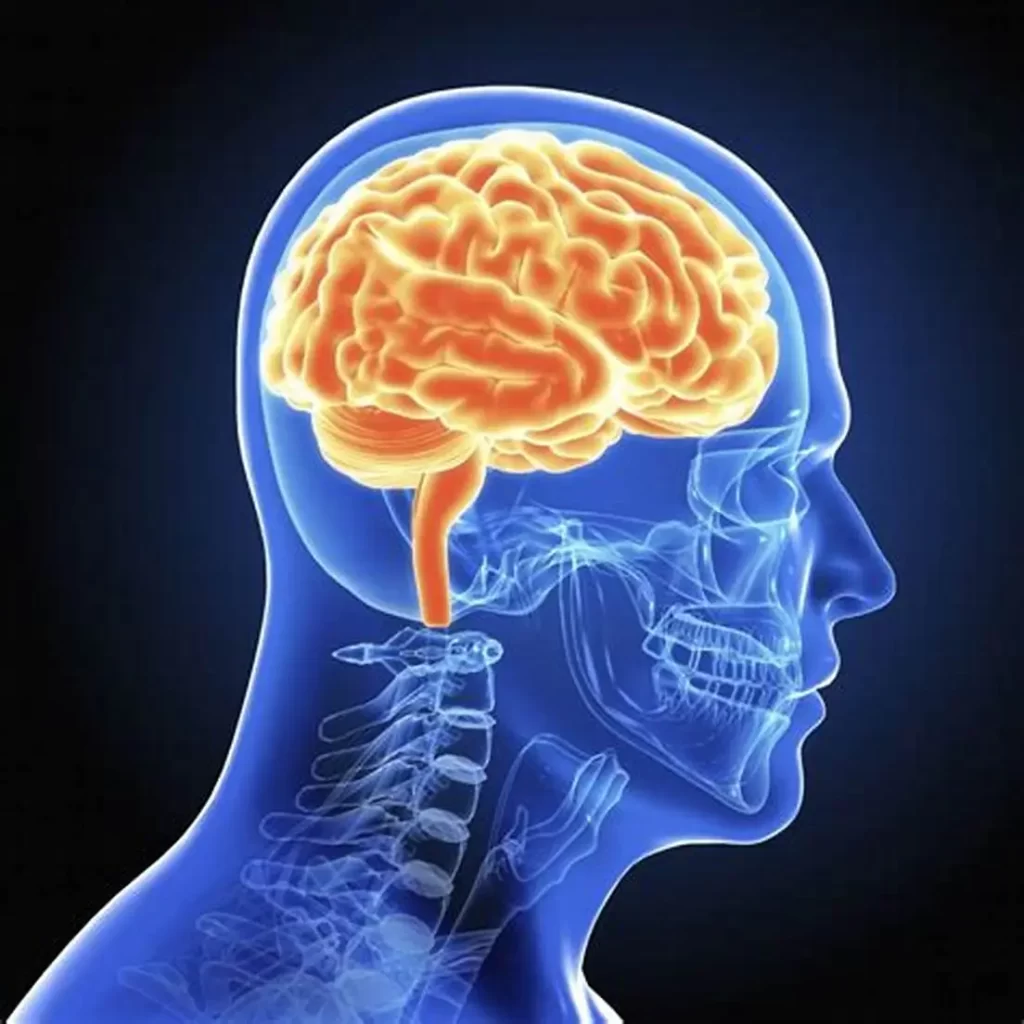
The brain is a complex organ that regulates all bodily functions, including thought, memory, emotion, touch, motor skills, vision, breathing, temperature, and hunger. The central nervous system, or nervous system, comprises the brain and the spinal cord that branches off of it. The body constantly receives and sends chemical and electrical messages from the brain. Various impulses control different processes, which your brain interprets. For instance, whilst some result in discomfort, others generate fatigue.
Some messages are kept in the brain, and others are sent from the spine to the body’s far-flung extremities through the vast network of nerves. Billions of neurons, or nerve cells, are used by the central nervous system to achieve this.
The cerebellum, brainstem, and cerebrum are the three main divisions of the brain. The brain and spinal cord are covered in three layers of tissue known as the meninges. The four areas of the brain, referred to as lobes, are frontal, parietal, temporal, and occipital in each hemisphere of the cerebrum. Particular functions are governed by each lobe.
There are four open regions and pathways located deep within the brain. They also open into the space underneath the meninges’ arachnoid layer and the central spinal canal. The brain is supplied with blood and oxygen by two distinct sets of blood vessels: the carotid and vertebral arteries.
The Skull
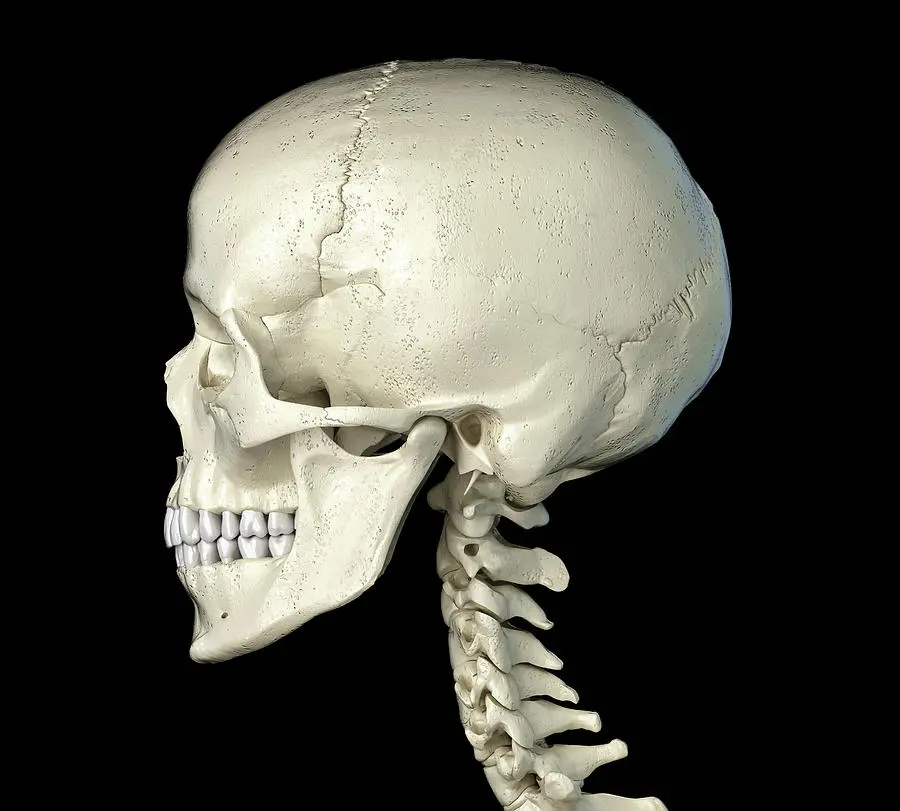
The human skull is made up of 22 bones (or 29 if the hyoid bone and inner ear bones are included), most of which are joined by ossified joints, sometimes known as sutures. The braincase (neurocranium) and the facial skeleton (viscerocranium) are the two sections of the skull. Its primary responsibility is to safeguard the brain, the body’s most vital organ.
The skull base and the skullcap, often known as the calvarium, make up the braincase. The pairs of parietal bones, as well as fragments of the frontal and occipital bones, make up the skull cap. The following are the human skull’s most significant sutures:
- The coronal suture, which connects the parietal and frontal bones
- The sagittal suture, divides the parietal bones in half.
- The occipital bone and the two parietal bones are separated horizontally by the lambdoidal suture.
Of the 33 sutures that the bones of the human skull form, these three are the most important.
The inferior part of the neurocranium is called the skull base. It can be separated into the anterior, middle, and posterior cranial fossae when viewed from the inside. Parts of the frontal, ethmoid, sphenoid, occipital, and temporal bones make up the base of the skull.
All of the skull bones that are anteroinferior to the cranial cavity are referred to as the face skeleton. The mandible (lower jaw) and maxilla (upper jaw) are prominent representations. The zygomatic, nasal, palatine, lacrimal, vomer, and inferior nasal concha (lower turbinate) comprise the orbital and nasal cavity.
The Sensory Organs
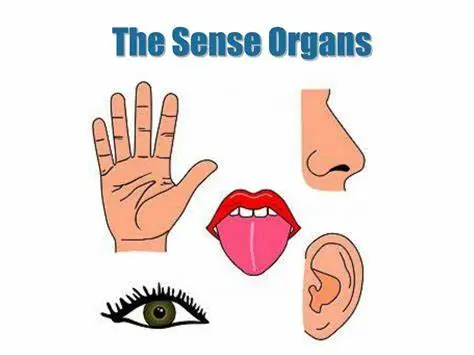
Specialized organs called sense organs help in our ability to perceive our surroundings. They are essential to our existence and the only sense that allows us to understand our surroundings.
Sense organs use a network of nerves and various organs to respond to specific physical phenomena by giving the information needed for interpretation. These senses govern our relationships and interactions with the outside world.
Our five sensory organs are as follows: eyes, ears, nose, tongue, and skin
These five sense organs have receptors that send information to the proper locations in the nervous system via sensory neurons. The general and special receptors are the two categories into which the receptors can be divided. Whereas the latter comprises mechanoreceptors, photoreceptors, and chemoreceptors, the former is distributed throughout the body.
Eyes – Sight or Ophthalmoception
These are our body’s visual sense organs. They react to images with light. Our eye color is determined by the quantity of melanin present in our bodies. Identifying and concentrating on bright pictures helps with the sense of sight.
The colored portion of the eye called the iris regulates the pupil’s diameter and size, which has an immediate impact on the amount of light that enters the eyes. The vitreous body is located below the eye’s lens. The vitreous humor, a gelatinous substance, fills it. This material gives the eyeball its shape and allows light to reach the retina, which is located at the extreme rear of the eyeball. Photoreceptors in this retina are used to sense light.
Ears – Hearing or Audioception
Our body’s auditory sensory organs are our ears. They help in our ability to hear sounds. We perceive sounds through our auditory system, which picks up vibrations in the atmosphere. This is referred to as audio captioning or hearing.
The three parts of the ear are the middle ear, inner ear, and outer ear. Since all sounds are essentially vibrations, the outer ear sends these vibrations into the ear canal, where the brain converts them into audible stimuli. This sense, in addition to hearing, is crucial for maintaining our equilibrium or bodily balance.
Tongue – Taste or Gustaoception
The tongue helps in the sense of various tastes and flavors. On the tongue, taste buds are located in between papillae and assist in the perception of various flavors. Taste and smell tend to collaborate. Something could not be tasted if it could not be smelled. Another name for the sense of taste is gustaoception.
Chemoreceptors found in taste buds on the tongue function similarly to those found in the nasal cavity. Though there are four various kinds of taste buds, each of which can detect different tastes like sweetness, sourness, bitterness, and saltiness, the chemoreceptors in the nose would sense any kind of smell.
Nose – Smell or Olfalcoception
One sense organ is the nose. We can tell the difference between various odors thanks to our olfactory system. Our perception of taste is also aided by this organ. Smell perception is also known as olfaction. The nasal cavity’s upper wall is often lined with olfactory cells. Olfactory cells have cilia on one end that protrude into the nasal cavity and olfactory nerve fibers on the other end.
Air enters the nasal cavity during inhalation. Because the olfactory cells are chemoreceptors, they possess protein receptors that enable them to differentiate between minute variations in substances. These substances attach themselves to the cilia, which transmit a nerve impulse to the brain. These impulses are subsequently translated by the brain into a detectable smell. The mucus produced by the body during a cold impairs scent perception, which explains why food feels bland.
Skin – Touch or Tactioception
The entire human body is made up of skin. It has to do with the tactile sense. The sensation of touch is often referred to as tactioception.
The skin has general receptors that can detect touch, pain, pressure, and temperature. They are found all over the skin. When skin receptors are active, an impulse is produced that travels to the brain via the spinal cord.
Other Sense Organs
Two additional sense organs aid in helping us orient ourselves in the world in addition to these five. They are as follows:
- Vestibular System
The vestibular system functions as the body’s sensory system and sends information about head position, motion, and spatial orientation to the brain. Additionally connected to motor functions, this system aids in:
- Keep our bodies in proper alignment.
- Keeping our physical equilibrium.
- While moving, keep our head and body steady.
- Recognizing how our bodies are positioned and oriented concerning our surroundings.
Thus, proper balance and mobility depend on the vestibular system.
2. Proprioception system
The awareness of joint position, whether conscious or unconscious, is referred to as the proprioception system. This system aids the body in recognizing its muscles, joints, and limbs in three dimensions as well as the direction in which it is moving concerning the body.
Proprioception includes things like walking or kicking without looking at our feet, balancing on one leg, touching our noses with closed eyes, and feeling the surface we are standing on.
The Torso and Its Vital Organs
Human Heart
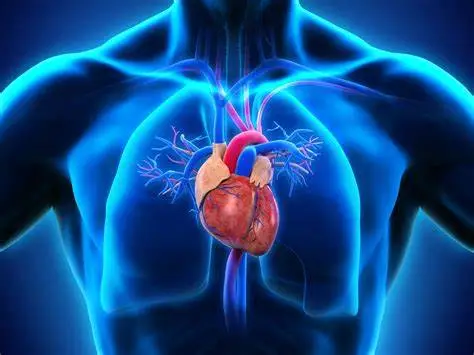
The muscular organ that makes up the heart is located at the front of the chest. It circulates blood throughout the body by pumping it there. The cardiovascular system consists of the blood arteries and the blood itself, excluding the heart. One of the most vital organs needed to keep life alive is the human heart. It is a four-chambered, muscular organ. The heart resembles a tightly balled fist in size.
One of the strongest and hardest-working muscles in the human body, the heart continues to beat throughout an individual’s life. Any organism’s heart’s function is to keep the blood flowing through the body continuously. The tissues and cells therefore get new nutrients and oxygen.
The heart serves the primary purposes listed below:
- The pumping of blood throughout the body is one of the heart’s main jobs.
- Blood carries many components, including hormones, carbohydrates, and oxygen, to every area of the body, including the heart.
- Additionally, the heart makes sure that the body maintains a healthy blood pressure level.
The body has two different forms of circulation: systemic circulation and pulmonary circulation.
Two ventricles and two atria make up the four chambers of the human heart. It is roughly the size of a fist. The chambers that receive blood are called the atrium, while the chambers that pump blood are called ventricles. The “right heart” is comprised of the right atrium and ventricle, whereas the “left heart” is made up of the left atrium and ventricle. The aorta, the largest artery in the body, is located within the anatomy of the heart.
The septum, a wall of muscle, divides both sides of the heart. The right ventricle pumps blood to the lungs for reoxygenation through the pulmonary arteries. The closure of the right semilunar valve stops blood flow backward into the heart. The oxygenated blood is subsequently sent from the lungs to the left atrium via the pulmonary veins.
The Lungs
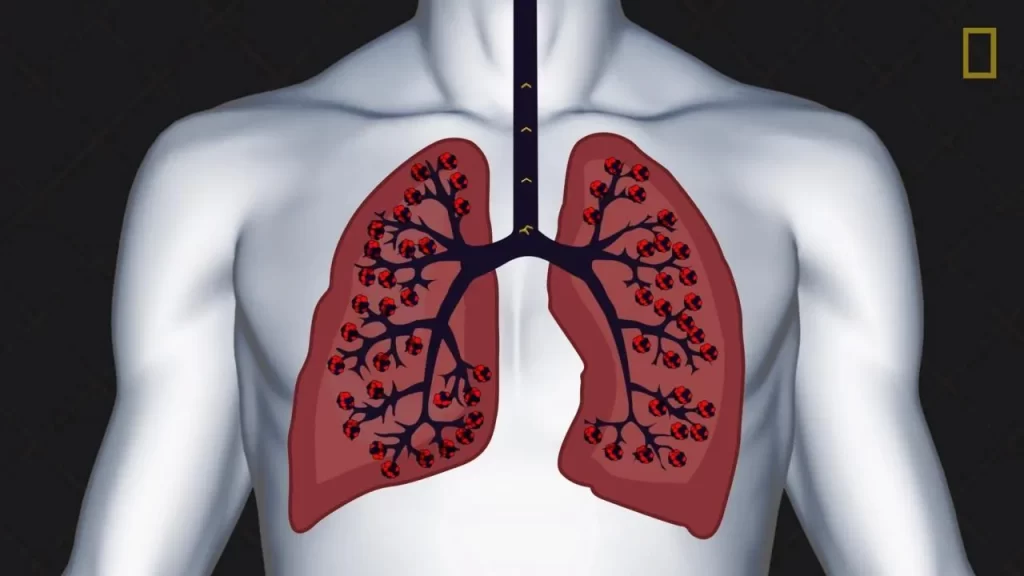
A vital component of the respiratory system, the lungs take in fresh air and expel old, stale air. Your breathing system enhances your ability to speak as well. The lungs can aid in the movement of oxygen-rich blood throughout your body by absorbing fresh air. This is accomplished by drawing in air through the nose and directing it into the pulmonary capillaries, which develop into oxygen-rich cells that support breathing.
The body has two lungs, a left, and a right, however they are not the same size. The left lung lobe is smaller and consists of just two lobes, whereas the right lung is larger and has three lobes that are separated by fissures. Due to its necessity for supporting the heart, the left lobe is likewise smaller.
The body receives its supply of fresh air from the lungs. By contracting its muscles during inhalation, the diaphragm aids in the upward movement of air into the lungs (relaxing pushes air out). Air passes via the trachea, into the bronchi, and fills the alveoli in the lungs after entering through the mouth and nose (with the aid of mucus, which prevents dust and dirt from entering the air). Air then makes its way to the blood arteries that encircle the alveoli. Oxygen is exchanged for carbon dioxide by the red blood cells, and the oxygen binds to hemoglobin molecules. The blood that has been oxygenated moves throughout the body. The lungs expel carbon dioxide and other gases that the body does not require.
The Digestive System
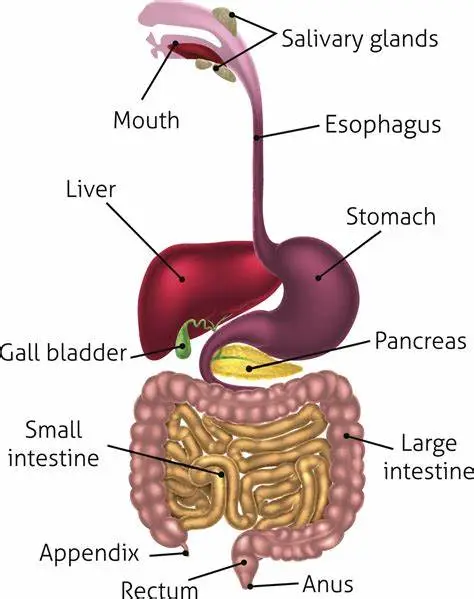
The digestive system in humans, which the body uses to carry out the digestion process. The digestive tract, or the collection of tissues and organs that pass through food and liquids as they are transformed into forms that may be absorbed into the bloodstream, constitutes the bulk of the digestive system in humans. The organs that supply the juices required for digestion as well as the structures that wastes go through throughout the evacuation process make up the system.
Stomach
The upper abdominal cavity contains the muscular, hollow, J-shaped stomach. Its primary function is to start the food’s digestion. The stomach can churn and break down food through muscular contractions called peristalsis because its walls are made of three layers of muscle. Gastric juices, which include pepsin and hydrochloric acid, are secreted by the stomach lining. These powerful ingredients aid in the digestion of proteins and the destruction of dangerous food microbes. The contents of the chyme, a viscous liquid produced by mechanical and chemical breakdown, are progressively discharged into the small intestine for additional digestion.
Liver
Beneath the diaphragm in the right upper belly is the huge, meaty organ known as the liver. It performs almost 500 vital functions! Producing bile for the digestion of fats, breaking down proteins, fats, and carbs, storing vital nutrients, and cleansing blood are some of its important functions. To keep waste materials, medications, and environmental pollutants from entering the systemic circulation, the liver breaks them down and filters them out of the bloodstream.
Intestines
The five-foot-long, tortuous small intestine comprises the duodenum, jejunum, and ileum portions.
The small intestine finishes the chemical breakdown of food with assistance from the pancreas’ digestive enzymes and the gallbladder’s bile. Villi, which are millions of microscopic projections that resemble fingers, increase the surface area so that nutrients including vitamins, minerals, proteins, carbohydrates, and lipids may be absorbed into the bloodstream. Any water left over is absorbed by the large intestine (colon), which also compacts indigestible waste into feces expelled.
The Kidneys
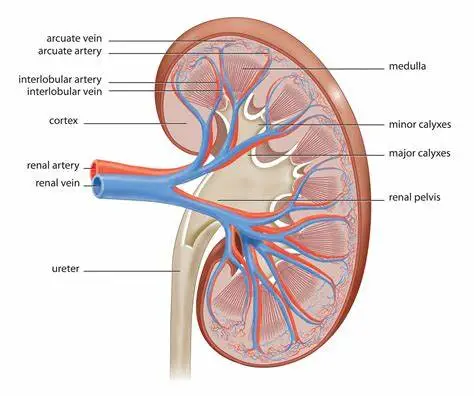
Your blood is filtered by the kidneys. The urinary system includes your kidneys. 200 quarts of fluid a day, or enough to fill a big bathtub, are filtered by your kidneys. Your kidneys eliminate waste during this procedure, which exits your body as urine. An individual typically needs to urinate twice daily. Your body recycles the remaining 198 quarts of fluid. The fluids and electrolytes in your body—mostly water—are also balanced by your kidneys. Sodium and potassium are two examples of important minerals that are electrolytes.
The kidneys provide a variety of vital purposes. They purify your blood of waste products and poisons. Common waste products include acids, muscle waste (creatinine), and nitrogen waste (urea). They help in your body’s removal of toxic waste. About half a cup of blood is filtered by your kidneys every minute.
Additionally,
- The kidneys regulate your blood’s pH balance and acid-base equilibrium.
- If there is not enough sugar in your blood, make sugar (glucose).
- Produce renin, a protein that raises blood pressure.
- Create the hormones erythropoietin and calcitriol. A kind of vitamin D called calcitriol aids in the body’s absorption of calcium. Erythropoietin aids in the production of red blood cells in your body.
The Limbs
The Arms
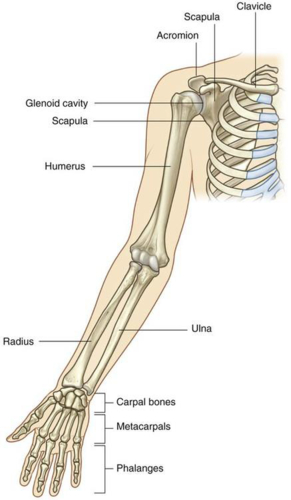
Bone structure: The humerus, which is located in the upper arm, and the radius and ulna, which are located in the forearm, make up each arm. While the ulna and radius link to the wrist bones, the humerus joins the arm to the shoulder socket.
Major muscles: The two primary muscle groups responsible for enabling arm movement are the triceps and biceps. The biceps, which are found in front of the upper arm, enable elbow flexion, which bends the arm. Arm extension is made possible by the triceps, which are located at the rear of the upper arm.
Functions: The muscles and bones of the arms combine to give the upper body strength and mobility for a variety of motions. This involves the capacity to grasp, elevate, push, pull, toss, and perform other manipulations on items in our surroundings. Writing, using tools, and making art are among the other talents made possible by fine motor control in the arms.
The Hands
Bone structure: The hand’s skeletal system consists of the phalanges (14 finger bones), metacarpals (5 hand bones), and carpals (8 wrist bones). The amazing flexibility and dexterity of the human hand are attributed to this system of several connecting bones.
Dexterity and gripping: The hand’s remarkable range of motion can be attributed to its 27 bones and many joints. Additionally helpful in detecting characteristics like texture, temperature, and pressure are sensitive nerve endings. The ability to work in unison with the fingers allows the opposable thumb to tightly grasp and precisely handle items.
The Legs
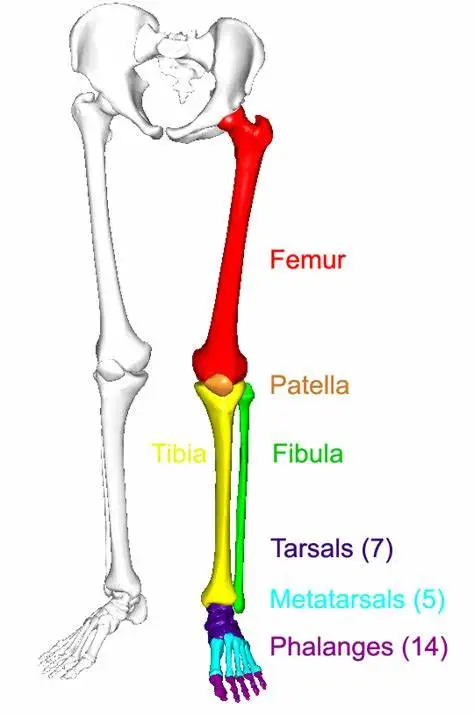
Bone structure: There are three primary bones in each leg: the tibia and fibula in the lower leg/calf area, and the femur in the upper leg/thigh area. The tibia and fibula attach to the ankle bones, whereas the femur attaches to the hip socket.
Major muscles: The two main muscle groups that support leg movement are the hamstrings, located in the back of the thighs, and the quadriceps, located in the front. The leg extension is made possible by the quadriceps muscles, which also enable straightening and kicking. To bend, the leg is flexed at the knee joint by the hamstring muscles.
Functions: The muscles and bones of the legs cooperate to give the body full-length mobility and structural support. Basic motions including walking, running, jumping, climbing, and sitting/standing are made possible by the legs. The strong leg muscles are also essential for bearing the upper body’s weight.
The Feet
Bone structure: The 26 bones in each foot are divided into three primary groups: the phalanges (14 toe bones), the metatarsals (5-foot bones), and the tarsals (7 ankle bones). This arrangement creates a flexible, semi-rigid arching foot framework.
Balance and propulsion: When standing or moving, the feet serve as a stable basis that evenly divides the body’s weight between the legs. The arched design aids in impact absorption and balance maintenance when flexed muscles and joints are used. The unique skeletal structure of the feet also permits the vital toe push-off necessary for running and walking.
The Support Systems
The Skeletal System
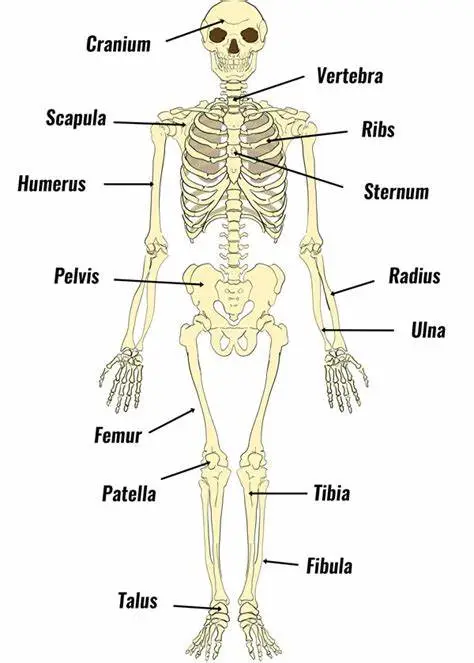
The skeletal system gives the muscles a point of attachment and helps protect the body’s interior organs. Humans have an endoskeleton, which is the layer of bone that lies beneath the muscles and skin. Other species, like insects, have an exoskeleton covering their exterior bodies. The skeletal system in humans is made up of bones, joints, and related cartilage. A mature human body consists of 206 bones and many joints.
The axial skeleton and the appendicular skeleton make up the two parts of the human skeleton. The skull, spine, and ribcage are all parts of the axial skeleton, which is shaped around the body’s central axis. It shields the main sense organs, including the eyes, ears, nose, tongue, brain, spinal cord, heart, lungs, and esophagus. The bones of the arms and legs, as well as the shoulder and hip girdles, make up the appendicular skeleton, which is connected to the limbs.
Protection: The skeletal system’s protection of the delicate interior organs is its next evident purpose. This is evident in the human skull, which fully encloses the brain. The ribcage, which surrounds the heart and lungs but yet allows expansion, is another example of it. To fend off predators, even invertebrates with robust exoskeletons, such as prawns and snails, frequently have them.
Blood Cell Production: The bone marrow, the main location for adult humans to produce red blood cells, is located in the center of a bone. Adults have two different forms of bone marrow. About half of the bone marrow is red, containing supporting tissue and hematopoietic stem cells. The remaining portion of the bone marrow is composed of fat, which turns yellow as we age.
Production of Other Cell Types: The skeletal system’s bone marrow is where a variety of different cells are produced in addition to red blood cells. Among them are lymphocytes, immunological cells that move through the lymphatic system. The skeletal system not only supports immune system functions but also houses stem cells that can differentiate into muscle, cartilage-producing, and bone-forming cells (osteoblasts).
Storing Minerals: The skeletal system’s bones serve as a calcium ion storage, adjusting the amount of mineralized deposits inside of them to keep the plasma calcium ion concentration within a specific range. Every cell’s plasma membrane has essential sodium ion channels, which are impacted by calcium ions and might compromise general equilibrium.
The Muscular System
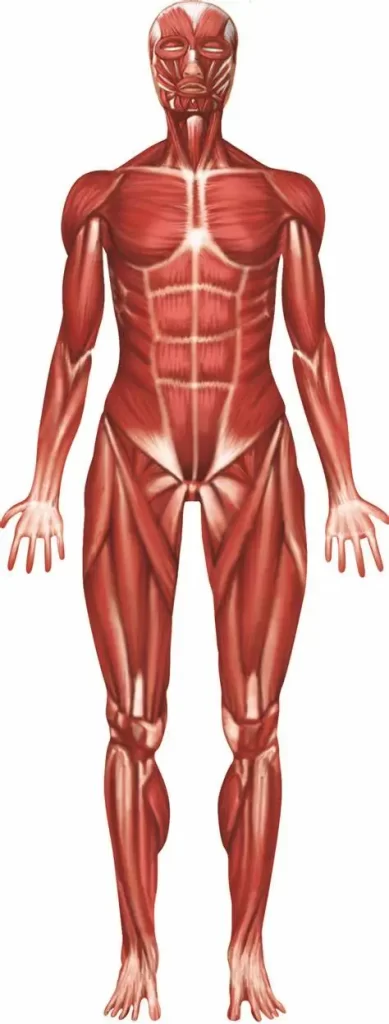
One organ system that is primarily involved in bodily movement is the muscular system. Roughly half of a person’s body weight is composed of their 700+ muscles, which are attached to their skeletal system. Made up of skeletal muscle tissue, tendons, nerves, and blood arteries, each muscle is a unique organ. The heart, blood vessels, and digestive system all contain muscle tissues.
Muscle tissues are classified into three types: skeletal, visceral, and cardiac.
Cardiac Muscle: There are only cardiac muscles in the heart. These muscles are in charge of the heart’s pumping function, which in turn controls blood circulation throughout the body. When examined under a microscope, the straight heart muscle cells appear to have dark and bright stripes. The arrangement of protein fibers causes the black and light stripes in the cells.
Visceral Muscle: Organs include the stomach, blood arteries, and intestines have visceral muscles. The contractions that these muscle tissues produce inside the organs help in the movement of materials throughout the organs. These muscles are likewise classified as involuntary as their activity cannot be deliberately regulated. Spindle-shaped, uninucleated cells make up the visceral muscle. Because of its homogeneous and smooth appearance under a microscope, it is also referred to as a smooth muscle.
Skeletal Muscle: The voluntary muscles in the body are called skeletal muscles. These muscles can be made to contract with conscious thought. These muscles are useful for carrying out bodily tasks including walking, lifting, and writing. The bodily parts that are attached to the bone can move because of the skeletal muscle. Skeletal muscle cells are cylindrical, striated, and multinucleated.
The Control Centers
The Nervous System
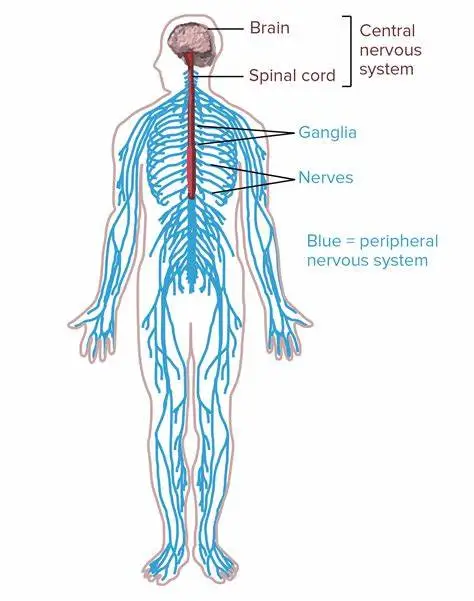
The primary function of the nervous system, which is made up of a network of neurons, is to create, modify, and transfer information throughout the entire body. This characteristic makes it possible for the nervous system to perform a wide range of critical tasks, including the control of respiration, digestion, heart rate, sensation, and movement. Everything that ultimately defines us as humans—including our consciousness, cognition, behavior, and memories—is governed by the structures of the nervous system.
The nervous system is divided into:
- Central nervous system (CNS): The body’s command and integration center is the central nervous system (CNS).
- Peripheral nervous system (PNS): The PNS serves as a conduit between the central nervous system (CNS) and the body. Two more divisions are the somatic nervous system (SNS) and the autonomic nervous system (ANS).
The nervous system sends electrical and chemical impulses quickly throughout the body by using specialized nerve cells called neurons. Sensory neurons receive sensory data and send electrical impulses to the central nervous system (CNS) for processing to perceive stimuli such as light, sound, and smell. Motor neurons receive electrical impulses from the brain and spinal cord that direct muscles to contract or secrete secretions from glands.
Neurons transform electrical signals into chemical neurotransmitters at junctions known as synapses, which then transfer the signal to the subsequent cell or organ of importance. The nervous system serves as the body’s communication center by gathering information from the senses, processing it in the central nervous system (CNS), and then transmitting commands to control all physiological processes, movements, and bodily functions.
The Endocrine System
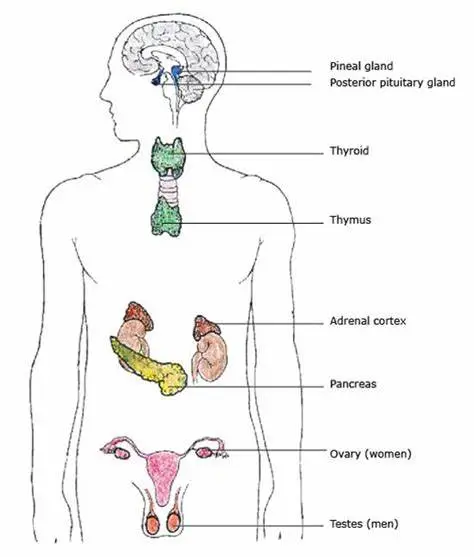
The structures in your body (mostly glands) that produce and release hormones are called the endocrine system. Hormones are chemicals that go through your bloodstream to interact with your organs, skin, muscles, and other tissues to control a variety of body functions. These signals are received by your body, which then knows what to do and when. Hormones are vital to your existence and well-being.
Your endocrine system’s primary function is to release hormones into your bloodstream while continuously checking their levels. To transmit their signals, hormones lock into the cells they intend to affect. There are more than 50 different hormones in your body, and they impact almost every part of your health, either directly or indirectly. Among the instances are:
- Endocrine glands create hormones, which are chemical messenger molecules.
- The bloodstream is filled with hormones released to travel to specific cells and organs.
- Hormones control and guide some bodily functions, including growth, metabolism, mood, appetite, sleep, and sexual function.
- They work gradually over time to keep the body in a state of homeostasis, or stable internal circumstances. Feedback loops based on blood hormone levels control the body’s production and release of these hormones. Hormone imbalances can cause diseases and disorders such as diabetes, infertility, and thyroid issues.
The Protective Layers
The Skin
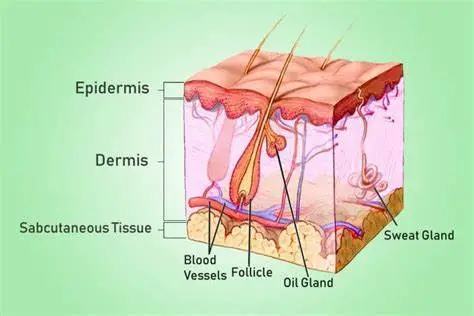
The epidermis, dermis, and hypodermis are the three primary layers of skin (subcutaneous tissue). There are more layers within these layers. The skin has eight or ten layers, depending on how you count the layers within the layers.
The largest and most complex organ in the body is the skin. Its main purpose is to protect against harmful surroundings and pathogens that cause disease. It also collects sensory data from your surroundings and aids in controlling body temperature.
- The skin’s outermost layer is called the epidermis. It protects the body from harm by acting as a waterproof barrier. Dead, flattened cells comprise the outermost layer, continuously losing old cells and growing new ones.
- The middle layer, or dermis, comprises blood vessels, sweat glands, hair follicles, and connective tissue. It does this by modifying blood flow and sweating to assist control of body temperature.
- The bottom layer, or hypodermis, is composed of fat cells. It cushions the layers of skin on the outside and serves as insulation to assist in controlling body temperature.
Roles in protection and temperature regulation
- Protection: The skin serves as a physical barrier to keep out dangerous substances, UV rays, germs, and excessive water loss. Special cells help in the fight against infections.
- Temperature regulation: The skin is essential for preserving a healthy internal body temperature. Dermal blood arteries can dilate or contract to alter blood flow and heat transmission. Sweat glands secrete moisture, which evaporates and cools the body.
- Other functions: The skin has nerve endings that are responsible for perceiving temperature, pressure, and pain. It retains fat, water, and vitamin D that is produced when exposed to sunshine.
The Immune System
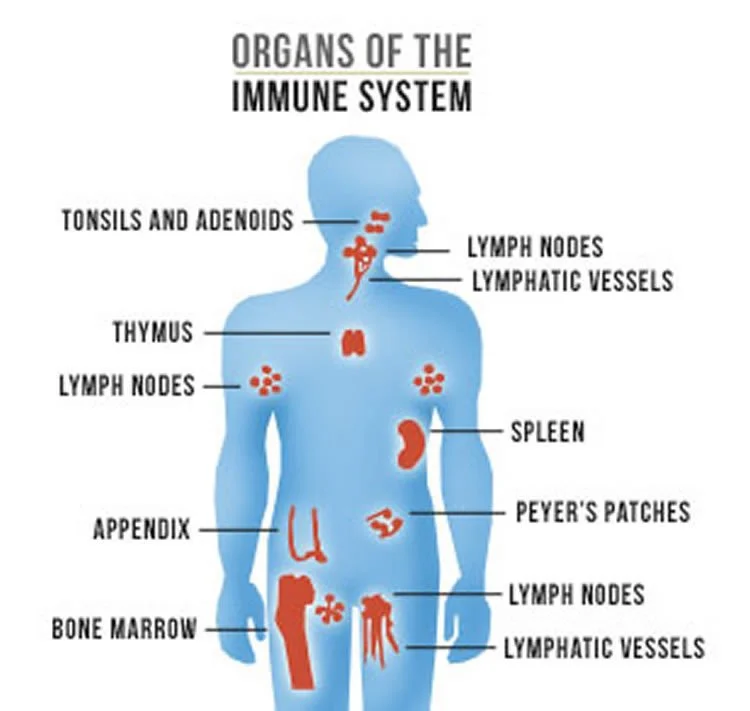
The body uses the immune system as a tool to prevent or control infection. The immune system protects the body against pathogens thanks to its complex network of tissues, proteins, organs, and cells.
An immune system that is working properly can tell undesirable chemicals from healthy tissue. It will launch a complex defense mechanism known as an immunological response if it finds something foreign, such as bacteria, viruses, or parasites. Moreover, it can identify and eliminate damaged and dead cells.
The immune system interprets incorrectly beneficial tissue as diseased in autoimmune disorders and allergies, causing an unwarranted attack that can result in uncomfortable and occasionally severe symptoms.
For the immune system to function properly, it must be able to differentiate between healthy and unhealthy cells and tissue. It does so by recognizing signals that are referred to as danger-associated molecular patterns, or DAMPS.
Cell damage can arise from a variety of sources, including:
- Infectious agents, like viruses or bacteria
- Poisons, like a sting or bite
- Physical harm that is not contagious, like a burn
- A genetic issue that arises in cells, as in the case of cancer
An antigen is typically a bacteria, fungal, virus, toxin, or foreign material. But it could also be a dead or defective cell. The immune system recognizes pathogen-associated molecular patterns, or PAMPs, in the antigen.
Summary
The human body is an incredible biological machine comprised of numerous interrelated systems and components that enable life itself. From the protective outer layers like the skin and immune system to the internal structural framework of the skeletal system and muscles, every part serves an essential role in sustaining our existence.
At the core lie the vital organs – the brain acting as the command center, the heart incessantly pumping life-giving blood, the lungs breathing in vital oxygen, the digestive system breaking down nutrients, and the kidneys filtering wastes. These organs are intricately regulated by the nervous system’s electrochemical signals and the endocrine system’s hormonal messengers. Together, they orchestrate the symphony of biological processes that allow us to move, grow, sense our surroundings, and respond to the ever-changing conditions of life.
Underlying it all is the sheer architectural genius – from the amenable design of our limbs that provide mobility and dexterity, to the multilayered composition of tissues affording protection, flexibility, and strength. The human body exemplifies nature’s crowning achievement of form wed to function on a molecular and macro scale. Understanding this extraordinary vessel we inhabit instills a profound appreciation for the precious gift of life itself.
FAQs
How many bones are in the adult human body?
206 bones make up the adult human skeletal system. This includes long bones in the limbs, short bones in the wrists and ankles, flat bones like the ribs, and irregular bones like the vertebrae.
Which organ in the human body is the largest?
The skin is the largest organ, with a total surface area of about 20 square feet. It serves as a protective barrier and plays a role in regulating temperature and enabling sensation.
How many muscles are in the human body?
An estimated 639 muscles are present in the human body. These are classified as skeletal muscles that control movement, smooth muscles lining organs, and cardiac muscles that make up the heart.
How many pints of blood are in the average adult?
The average adult has around 10 pints or 4.7 liters of blood circulating oxygen and nutrients throughout the body.
What percentage of the human body is water?
About 60% of the average adult human body is composed of water, which is essential for biological processes and temperature regulation.
How long can a person survive without water?
A person can generally survive around 3 days without drinking water under normal conditions before severe dehydration and health consequences.
Which organ works hardest in the human body?
The heart is considered the hardest working muscle, beating about 100,000 times per day to pump blood through the circulatory system.
What is the longest bone in the human body?
The femur or thigh bone is the longest bone, measuring around 19 inches in adults and enabling movement of the leg.
How many taste buds does the average human tongue have?
The average healthy tongue contains about 10,000 taste buds that allow us to detect sweet, sour, salty, bitter, and umami tastes.
How many times a day on average does a human heart beat?
The human heart beats approximately 100,000 times per day on average, pumping around 2,000 gallons of blood.
References
Shah, D. (2023, December 13). Body Parts Name – A Comprehensive Guide. Mobile Physiotherapy Clinic. https://mobilephysiotherapyclinic.in/body-parts-name/
Brain Anatomy and How the Brain Works. (2021, July 14). Johns Hopkins Medicine. https://www.hopkinsmedicine.org/health/conditions-and-diseases/anatomy-of-the-brain
Skull. (2023, November 21). Kenhub. https://www.kenhub.com/en/library/anatomy/the-skull
Admin. (2021, July 28). Sense Organs – List of Five Sense Organs and their Functions. BYJUS. https://byjus.com/biology/sense-organs/
Admin. (2023, August 23). Human Heart – Anatomy, Functions and Facts about Heart. BYJUS. https://byjus.com/biology/human-heart/#functions-of-the-human-heart
Travers, C. (2023, August 16). Anatomy of the Lungs. Verywell Health. https://www.verywellhealth.com/lung-anatomy-4843718
Digestive system. (2023, November 2). Kenhub. https://www.kenhub.com/en/library/anatomy/the-digestive-system
Professional, C. C. M. (n.d.). Kidney. Cleveland Clinic. https://my.clevelandclinic.org/health/body/21824-kidney#function
Klenerman, L. (2015). 7. The limbs. In Oxford University Press eBooks (pp. 112–134). https://doi.org/10.1093/actrade/9780198707370.003.0007
Buckley, G. (2021, January 15). Skeletal System. Biology Dictionary. https://biologydictionary.net/skeletal-system/
Admin. (2022, July 22). Muscular System- Types and functions of Muscles in the Human Body. BYJUS. https://byjus.com/biology/muscular-system/
Nervous system. (2023, November 3). Kenhub. https://www.kenhub.com/en/library/anatomy/the-nervous-system
Professional, C. C. M. (n.d.-a). Endocrine System. Cleveland Clinic. https://my.clevelandclinic.org/health/body/21201-endocrine-system
Brannon, H. L. (2023, May 19). Layers of Skin and Their Functions. Verywell Health. https://www.verywellhealth.com/skin-anatomy-1068880
Newman, T. (2023, November 22). How the immune system works. https://www.medicalnewstoday.com/articles/320101#immunity
https://th.bing.com/th/id/OIP.yvuZATHt1bwiJWzylOQT0wHaEK?rs=1&pid=ImgDetMain

